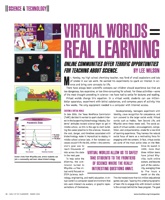Does real learning happen in virtual worlds? 
Cable in the Classroom Magazine published an article I wrote on this topic in their March issue.
The premise is:
“There have always been scientific concepts our children should experience that are too dangerous, too expensive, or too time-consuming for school. For these activities – some of the most thought provoking in science – we have had to settle for lectures and reading.
Virtual worlds change this equation. In a virtual world, students can use million dollar apparatus, experiment with lethal substances, and compress years of activity into a few weeks….”
The article goes on to describe how the Texas Workforce Commission is using Whyville as an outreach vehicle for biotechnology. It also addresses why virtual worlds are particularly attractive to tweens because of where they are developmentally.
If you have thoughts on what I wrote leave a comment here and I’ll respond.
Download the complete article (PDF) by clicking on the image to the right.
All the links referenced in the article are below the fold – continue reading to see them.
Continue reading
 Kid’s virtual world Club Penguin has fallen short of the high-flying projections made when Disney purchased them 3 years ago.
Kid’s virtual world Club Penguin has fallen short of the high-flying projections made when Disney purchased them 3 years ago. The Education Business Blog
The Education Business Blog






 Technology & Learning On-Line has launched a set of forums on education technology issues. For some odd reason they selected me to moderate the
Technology & Learning On-Line has launched a set of forums on education technology issues. For some odd reason they selected me to moderate the